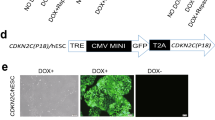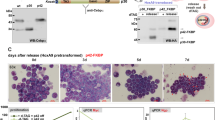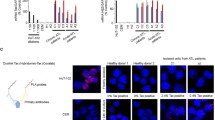Abstract
Deregulated expression of the myc-family of oncogenes in hematopoietic and other cell types plays an important role in tumorigenesis, and results in increased proliferative potential and block of cellular differentiation. We have previously shown that IFN-γ restores phorbol ester-induced differentiation and cell cycle arrest in v-myc transformed human U-937 monoblasts. To investigate whether other cytokine signals could also abrogate such a block, IL-1, IL-3, IL-4, IL-6, IL-7, IL-10, IL-11, LIF, oncostatin M, M-CSF, G-CSF and GM-CSF, and TGFβ1, TNF-α, IFN-α were examined. We show that GM-CSF and IL-6, in combination with the phorbol ester 12-O-tetradecanoyl-phorbol acetate (TPA), restored differentiation and cell cycle arrest. In contrast, treatment by TGFβ1 ± TPA resulted in an efficient G1/G0 arrest, but did not appear to induce terminal differentiation. Restoration of differentiation and cell cycle arrest was accomplished despite maintained expression of the v-Myc protein. Our results show that the cytokine-induced signals reduced Myc-dependent transcription of an artificial target promoter/reporter gene construct, correlating in most, but not all, cases with decreased association of v- and c-Myc with its essential partner, Max. Thus, cytokine-induced signals may counteract the activity of deregulated Myc, and contribute to the normalization of differentiation, arrest in the G1/G0 phase of the cell cycle, or both.
This is a preview of subscription content, access via your institution
Access options
Subscribe to this journal
Receive 12 print issues and online access
$259.00 per year
only $21.58 per issue
Buy this article
- Purchase on Springer Link
- Instant access to full article PDF
Prices may be subject to local taxes which are calculated during checkout






Similar content being viewed by others
References
Henriksson M, Lüscher B . Proteins of the Myc network: essential regulators of cell growth and differentiation Adv Cancer Res 1996 68: 109–182
Dang CV . c-Myc target genes involved in cell growth, apoptosis, and metabolism Mol Cell Biol 1999 19: 1–11
Field JK, Spandidos DA . The role of ras and myc oncogenes in human solid tumours and their relevance in diagnosis and prognosis (review) Anticancer Res 1990 10: 1–22
Spencer CA, Groudine M . Control of c-myc regulation in normal and noeplastic cells Adv Cancer Res 1991 56: 1–48
Marcu KB, Bossone SA, Patel AJ . myc function and regulation Annu Rev Biochem 1992 61: 809–860
Coppola JA, Cole MD . Constitutive c-myc oncogene expression blocks mouse erythroleukaemia cell differentiation but not commitment Nature 1986 320: 760–763
Dmitrovsky E, Kuehl WM, Hollis GF, Kirsch IR, Bender TP, Segal S . Expression of a transfected human c-myc oncogene inhibits differentiation of a mouse erythroleukaemia cell line Nature 1986 322: 748–750
Prochownik EV, Kukowska J . Deregulated expression of c-myc by murine erythroleukaemia cells prevents differentiation Nature 1986 322: 848–850
Schneider MD, Perryman MB, Payne PA, Spizz G, Roberts R, Olson EN . Autonomous expression of c-myc in BC3H1 cells partially inhibits but does not prevent myogenic differentiation Mol Cell Biol 1987 7: 1973–1977
Freytag SO . Enforced expression of the c-myc oncogene inhibits cell differentiation by precluding entry into a distinct predifferentiation state in G0/G1 Mol Cell Biol 1988 8: 1614–1624
Griep AE, Westphal H . Antisense Myc sequences induce differentiation of F9 cells Proc Natl Acad Sci USA 1988 85: 6806–6810
Larsson LG, Ivhed I, Gidlund M, Pettersson U, Vennström B, Nilsson K . Phorbol ester-induced terminal differentiation is inhibited in human U-937 monoblastic cells expressing a v-myc oncogene Proc Natl Acad Sci USA 1988 85: 2638–2642
Hoffman Liebermann B, Liebermann DA . Interleukin-6- and leukemia inhibitory factor-induced terminal differentiation of myeloid leukemia cells is blocked at an intermediate stage by constitutive c-myc Mol Cell Biol 1991 11: 2375–2381
Resnitzky D, Kimchi A . Deregulated c-myc expression abrogates the interferon- and interleukin 6-mediated G0/G1 cell cycle arrest but not other inhibitory repsonses in M1 myeloblastic cells Cell Growth Differ 1991 2: 33–41
Miner JH, Wold BJ . c-myc inhibition of MyoD and myogenin-initiated myogenic differentiation Mol Cell Biol 1991 11: 2842–2851
Chisholm O, Stapleton P, Symonds G . Constitutive expression of exogenous myc in myelomonocytic cells: acquisition of a more transformed phenotype and inhibition of differentiation induction Oncogene 1992 7: 1827–1836
Holt JT, Redner RL, Nienhuis AW . An oligomer complementary to c-myc mRNA inhibits proliferation of HL-60 promyelocytic cells and induces differentiation Mol Cell Biol 1988 8: 963–973
Blackwood EM, Eisenman RN . Max: a helix–loop–helix zipper protein that forms a sequence-specific DNA-binding complex with Myc Science 1991 251: 1211–1217
Prednergast GC, Lawe D, Ziff EB . Association of Myn, the murine homolog of max, with c-Myc stimulates methylation-sensitive DNA binding and ras cotransformation Cell 1991 65: 395–407
Grandori C, Eisenman RN . Myc target genes Trends Biochem Sci 1997 22: 177–181
Lüscher B, Larsson LG . The basic region/helix–loop–helix/leucine zipper domain of Myc proto-oncoproteins: function and regulation Oncogene 1999 18: 2955–2966
McArthur GA, Laherty CD, Quéva C, Hurlin PJ, Loo L, James L, Grandori C, Gallant P, Shiio Y, Hokanson WC, Bush AC, Cheng PF, Lawrence QA, Pulverer B, Koskinen PJ, Foley KP, Ayer DE, Eisenman RN . The Mad protein family links transcriptional repression to cell differentiation CSH Symp Quant Biol 1998 LXIII: 423–433
Foley KP, Eisenman RN . Two MAD tails: what the recent knockouts of Mad1 and Mxi1 tell us about the MYC/MAX/MAD network Biochim Biophys Acta 1999 1423: M37–47
Öberg F, Larsson LG, Anton R, Nilsson K . Interferon gamma abrogates the differentiation block in v-myc-expressing U-937 monoblasts Proc Natl Acad Sci USA 1991 88: 5567–5571
Bahram F, Wu S, Öberg F, Luscher B, Larsson LG . Posttranslational regulation of myc function in response to phorbol ester/interferon-gamma-induced differentiation of v-myc-transformed U-937 monoblasts (in process citation) Blood 1999 93: 3900–3912
Sundström C, Nilsson K . Establishment and characterization of a human histiocytic lymphoma cell line (U-937) Int J Cancer 1976 17: 565–577
Auffray C, Rougeon F . Purification of mouse immunoglobulin heavy-chain messenger RNAs from total myeloma tumor RNA Eur J Biochem 1980 107: 303–314
Seiler Tuyns A, Birnstiel ML . Structure and expression in L-cells of a cloned H4 histone gene of the mouse J Mol Biol 1981 151: 607–625
Tso J, Sun XH, Kao TH, Reece KS, Wu R . Isolation and characterization of rat and human glyceraldehyde-3-phosphate dehydrogenase cDNAs: genomic complexity and molecular evolution of the gene Nucleic Acids Res 1985 13: 2485–2502
Larsson L-G, Bahram F, Burkhardt H, Lüscher B . Analysis of the DNA-binding activities of Myc/Max/Mad network complexes during induced differentiation of U-937 monoblasts and F9 teratocarcinoma cells Oncogene 1997 15: 737–748
Todd RD, Schlossman SF . Analysis of antigenic determinants on human monocytes and macrophages Blood 1982 59: 775–786
Miller LJ, Schwarting R, Springer TA . Regulated expression of the Mac-1, LFA-1, p150,95 glycoprotein family during leukocyte differentiation J Immunol 1986 137: 2891–2900
Öberg F, Botling J, Nilsson K . Functional antagonism between vitamin D3 and retinoic acid in the regulation of CD14 and CD23 expression during monocytic differentiation of U-937 cells J Immunol 1993 150: 3487–3495
Osley MA . The regulation of histone synthesis in the cell cycle Annu Rev Biochem 1991 60: 827–861
Schindler C, Darnell Jr J . Transcriptional responses to polypeptide ligands: the JAK-STAT pathway Annu Rev Biochem 1995 64: 621–651
Minami M, Inoue M, Wei S, Takeda K, Matsumoto M, Kishimoto T, Akira S . STAT3 activation is a critical step in gp130-mediated terminal differentiation and growth arrest of a myeloid cell line Proc Natl Acad Sci USA 1996 93: 3963–3966
Bromberg JF, Horvath CM, Wen Z, Schreiber RD, Darnell Jr J . Transcriptionally active Stat1 is required for the antiproliferative effects of both interferon alpha and interferon gamma Proc Natl Acad Sci USA 1996 93: 7673–7678
Chin YE, Kitagawa M, Su WC, You ZH, Iwamoto Y, Fu XY . Cell growth arrest and induction of cyclin-dependent kinase inhibitor p21 WAF1/CIP1 mediated by STAT1 Science 1996 272: 719–722
Bellido T, O'Brien CA, Roberson PK, Manolagas SC . Transcriptional activation of the p21 (WAF1, CIP1, SDI1) gene by interleukin-6 type cytokines. A prerequisite for their pro-differentiating and anti-apoptotic effects on human osteoblastic cells J Biol Chem 1998 273: 21137–21144
Matsumura I, Ishikawa J, Nakajima K, Oritani K, Tomiyama Y, Miyagawa J, Kato T, Miyazaki H, Matsuzawa Y, Kanakura Y . Thrombopoietin-induced differentiation of a human megakaryoblastic leukemia cell line, CMK, involves transcriptional activation of p21 (WAF1/Cip1) by STAT5 Mol Cell Biol 1997 17: 2933–2943
Grant S, Bhalla K, Weinstein B, Pestka S, Mileno MD, Fisher PB . Recombinant human interferon sensitizes resistant myeloid leukemic cells to induction of terminal differentiation Biochem Biophys Res Commun 1985 130: 379–388
Massague J . TGF-beta signal transduction Annu Rev Biochem 1998 67: 753–791
De Benedetti F, Falk LA, Ellingsworth LR, Ruscetti FW, Faltynek CR . Synergy between transforming growth factor-beta and tumor necrosis factor-alpha in the induction of monocytic differentiation of human leukemic cell lines Blood 1990 75: 626–632
Coffey Jr RJ, Bascom CC, Sipes NJ, Graves Deal R, Weissman BE, Moses HL . Selective inhibition of growth-related gene expression in murine keratinocytes by transforming growth factor beta Mol Cell Biol 1988 8: 3088–3093
Pietenpol JA, Holt JT, Stein RW, Moses HL . Transforming growth factor beta 1 suppression of c-myc gene transcription: role in inhibition of keratinocyte proliferation Proc Natl Acad Sci USA 1990 87: 3758–3762
Alexandrow MG, Kawabata M, Aakre M, Moses HL . Overexpression of the c-Myc oncoprotein blocks the growth-inhibitory response but is required for the mitogenic effects of transforming growth factor beta 1 Proc Natl Acad Sci USA 1995 92: 3239–3243
Warner BJ, Blain SW, Seoane J, Massague J . Myc downregulation by transforming growth factor beta required for activation of the p15(Ink4b) G(1) arrest pathway Mol Cell Biol 1999 19: 5913–5922
Ayer DE, Kretzner L, Eisenman RN . Mad: a heterodimeric partner for Max that antagonizes Myc transcriptional activity Cell 1993 72: 211–222
Hurlin PJ, Queva C, Koskinen PJ, Steingrimsson E, Ayer DE, Copeland NG, Jenkins NA, Eisenman RN . Mad3 and Mad4: novel Max-interacting transcriptional repressors that suppress c-myc dependent transformation and are expressed during neural and epidermal differentiation Embo J 1995 14: 5646–5659
Cultraro CM, Bino T, Segal S . Function of the c-Myc antagonist Mad1 during a molecular switch from proliferation to differentiation Mol Cell Biol 1997 17: 2353–2359
Acknowledgements
We thank Nina Hult for important contributions during the early phase of this study and Inger Karlberg for excellent technical assistance. We also thank Drs GR Adolf, S Clark, S Gillis, T Kishimoto and M Sporn for generous gifts of cytokines. This work was supported by grants from the Swedish Cancer Society, the Children Cancer Foundation of Sweden, the von Kantzow Foundation, and the Lovisa and Thielmann Foundation.
Author information
Authors and Affiliations
Rights and permissions
About this article
Cite this article
Öberg, F., Wu, S., Bahram, F. et al. Cytokine-induced restoration of differentiation and cell cycle arrest in v-Myc transformed U-937 monoblasts correlates with reduced Myc activity. Leukemia 15, 217–227 (2001). https://doi.org/10.1038/sj.leu.2402025
Received:
Accepted:
Published:
Issue Date:
DOI: https://doi.org/10.1038/sj.leu.2402025



